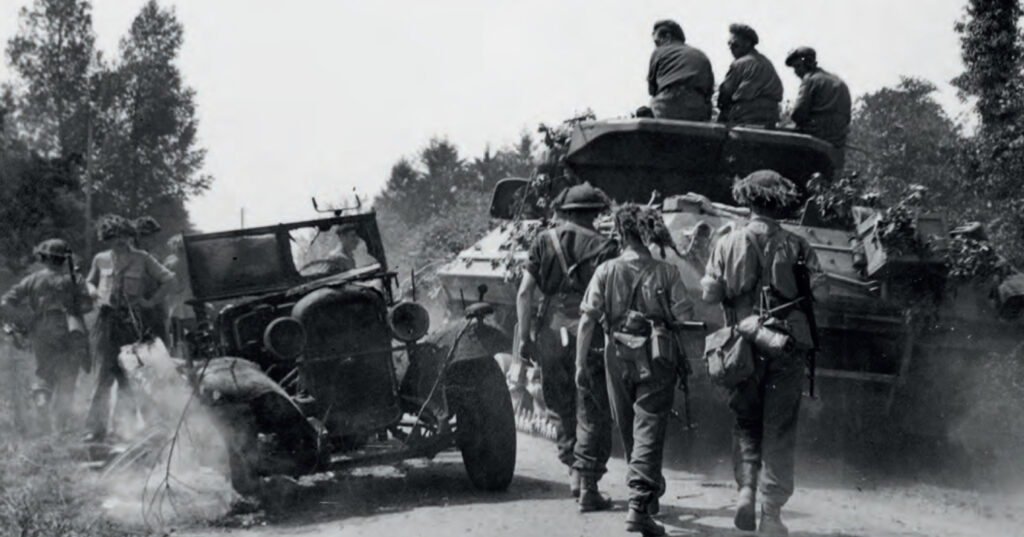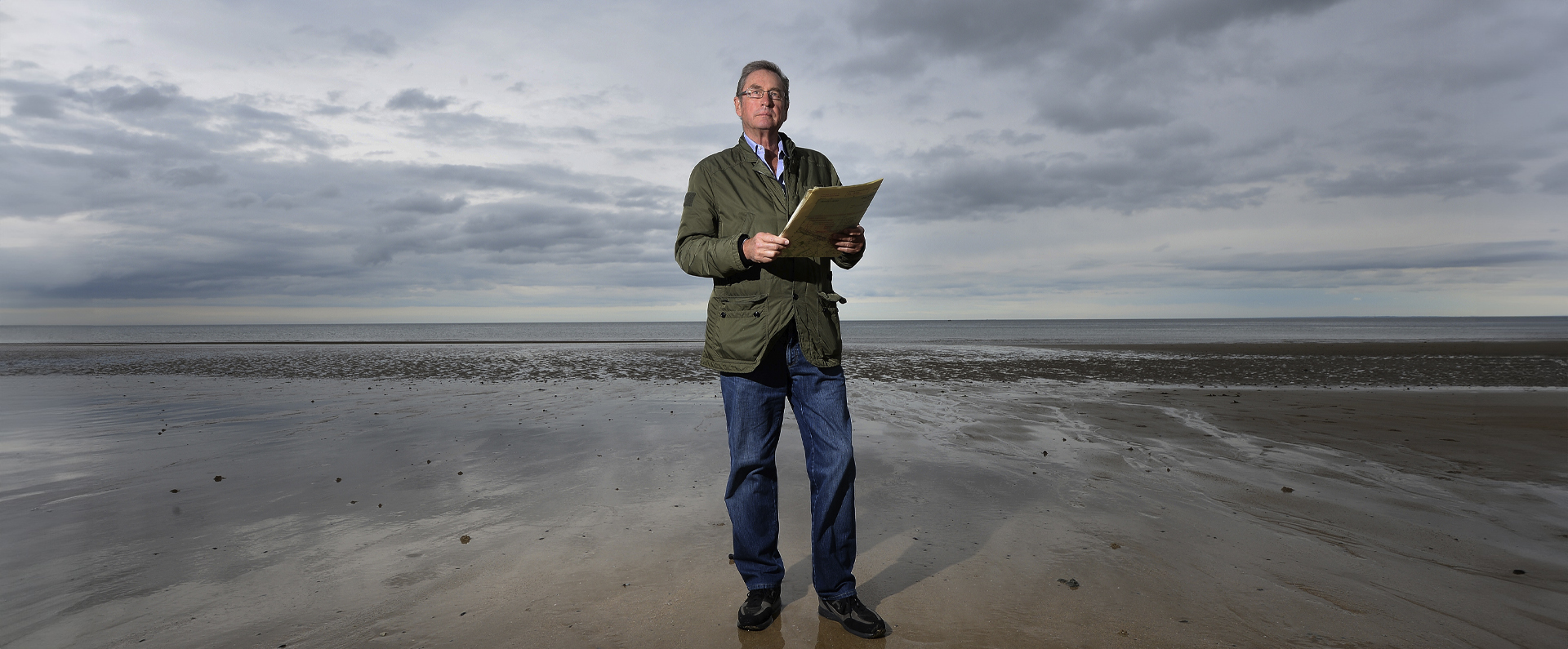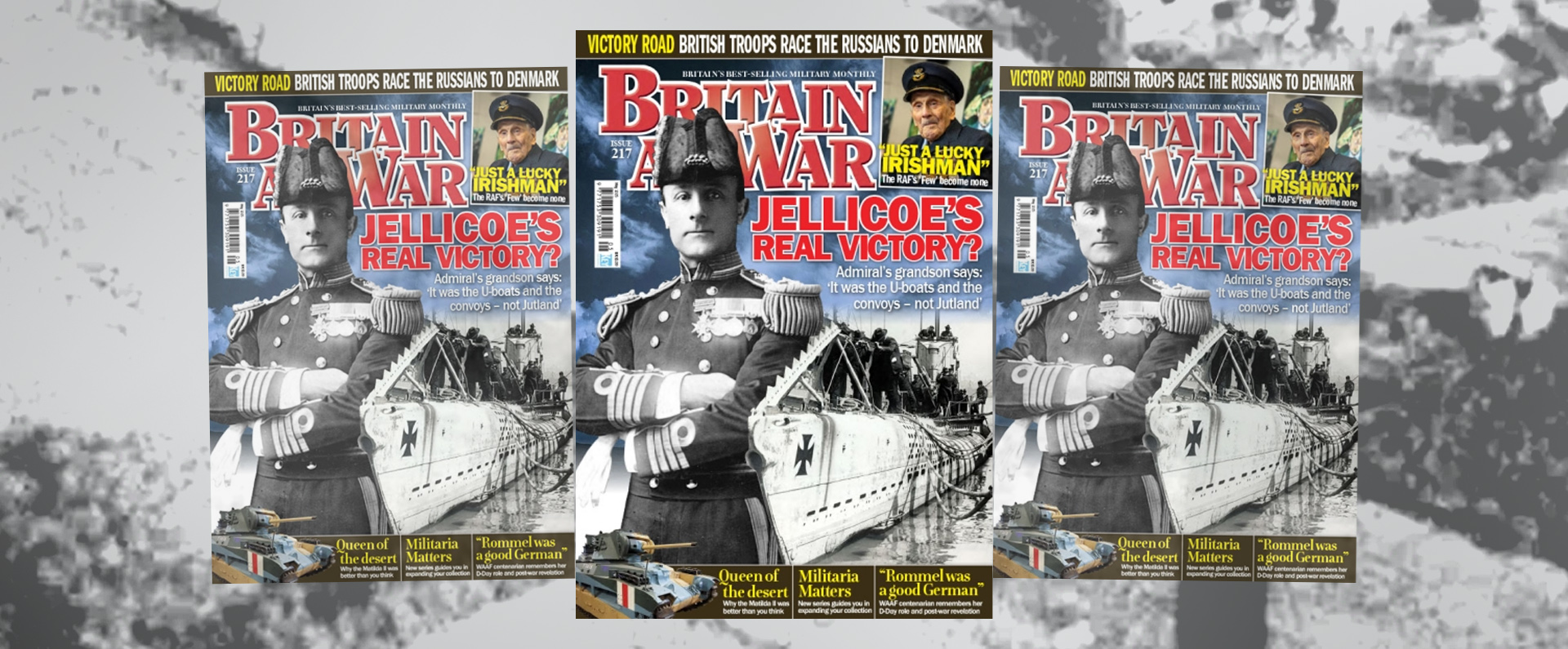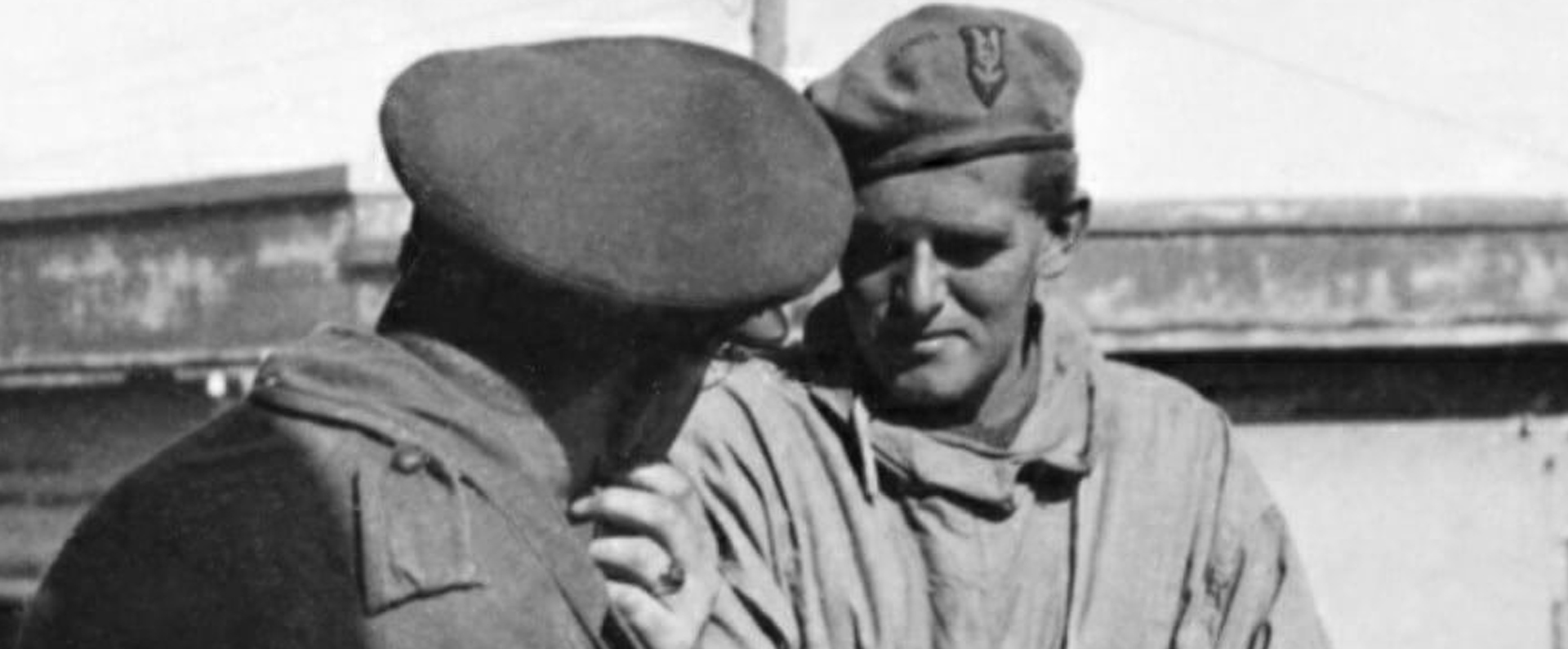
Published in Britain at War in November 2019.
Company Sergeant Major Edward Thomas Chapman VC BEM
Edward Chapman was awarded his Victoria Cross for a superb action in the final weeks of the Second World War in Europe. By the nature of the attack, an enemy ambush can cause fear and havoc but the way that Chapman responded to the crisis was quite incredible.
Edward Chapman was born in Pontlottyn, Glamorgan, on January 13 1920. He was the second of four sons born to Evan Chapman, a miner, and his wife Rachel (née Saunders). Edward Chapman, who spoke Welsh, attended Fochriw School until the age of fourteen when he followed his father ‘down the pit’, working at Ogilvie Colliery, New Tredegar.
On April 19 1940, Chapman, who was usually known as “Ted”, was enlisted in The Monmouthshire Regiment and assigned to the 2nd Battalion, based in Northern Ireland. Here, his regiment was part of 160th Brigade of the 53rd (Welsh) Division that had two principal tasks: to protect the province from invasion and to guard civilians against any terrorism from the IRA. In October 1941, the battalion was transferred to Leominster, Herefordshire.
While on a visit to Belfast, Chapman had met and, eventually, became engaged to a local girl, Rhoda Watkins. Their wedding was arranged in Belfast for early 1942 by which point Chapman was still based in Leominster. Because he was determined to get married in a civilian suit rather than in uniform, and with time short, Chapman went absent without leave for the final fitting. On his return to camp, he was arrested and his sentence was to be confined to barracks for a week. This meant he could not get to Belfast and, after he failed to turn up and his fiancée had heard nothing from him, she became convinced she had been jilted.
Eventually, when she learnt of Chapman’s predicament, the wedding was postponed by a week. On March 26 1942, at Richview Church, Belfast, the couple got married with the groom in his military uniform: it was a double marriage celebration and Rhoda Watkins’ sister married her fiancé at the same time.
In the same month, Chapman and his regiment were moved to Rochester, Kent, to act as part of Britain’s defensive frontline. On June 25 1944, less than three weeks after the D-Day landings, the battalion arrived in Normandy and then advanced to the Low Countries, the Rhine Crossing and north-west Germany. By this point the 2nd Battalion, The Monmouthshire Regiment, had spent four years of relative inactivity and its members were anxious to see action. In August 1944, Chapman was wounded in the Falaise Pocket break-out, the decisive engagement in the Battle of Normandy, when a shell landed on his foot.
He made a quick recovery, however, and, after just five weeks in hospital, he was soon back on the front-line, this time posted to D Company in the regiment’s 3rd Battalion. On November 30, he was again in the thick of the action, part of the battalion that pushed the enemy back to the River Maas and then stormed a castle at Broekhuizen, near Horst. Despite suffering heavy casualties during heavy fighting, the 3rd Battalion took the village against a larger, dug-in enemy force.
There was no let-up for the battalion: after three weeks in Holland, it was moved to the Kleve area of western Germany, where it took part in the attack on the Schlieffen Line, the enemy’s last major position before the River Rhine. Yet again, both the fighting and the casualties were heavy. However, the Allies pressed on deep into Germany with the enemy now fighting desperately to defend their homeland.
By the third week of March, with the Allies by now across the Rhine, the 3rd Battalion, the Monmouthshire Regiment, was positioned in the Teutoburger Wald hills, preparing to move east to attack the Dortmund-Ems canal. Because of the difficult terrain, which included steep-sided woods, the area was unsuitable for tanks and other mechanised vehicles. This meant the advance would have to be an infantry assault and, at dawn on April 2 1945, four companies from Chapman’s battalion were ordered to enter the forest and try to clear the western edge of the ridge, north of Risenbeck.
It was at this action that Chapman showed such outstanding bravery that he was decorated. The citation for his subsequent VC, published on July 13 1945, gives a full account of what happened that day:
“On 2nd April, 1945, a Company of the Monmouthshire Regiment crossed the Dortmund-Ems canal and was ordered to assault the ridge of the Teutoberger [sic} Wald, which dominates the surrounding country. This ridge is steep, thickly wooded and is ideal defensive country. It was, moreover, defended by a battalion of German officer cadets and their instructors, all of them picked men and fanatical Nazis.
“Corporal Chapman was advancing with his section in single file along a narrow track, when the enemy suddenly opened fire with machine guns at short range, inflicting heavy casualties and causing some confusion. Corporal Chapman immediately ordered his section to take cover and, seizing the Bren gun, he advanced alone, firing the gun from his hip, and mowed down the enemy at point blank range, forcing them to retire in disorder.
“At this point, however, his Company was ordered to withdraw but Corporal Chapman and his section were still left in their advanced position, as the order could not be got forward to them.
“The enemy then began to close up to Corporal Chapman and his isolated section and, under cover of intense machine gun fire, they made determined charges with the bayonet. Corporal Chapman again rose with his Bren gun to meet the assaults and on each occasion halted their advance.
“He had now nearly run out of ammunition. Shouting to his section for more bandoliers [belts of ammunition], he dropped-into a fold in the ground and covered those bringing up the ammunition by lying on his back and firing the Bren gun over his shoulder. A party of Germans made every effort to eliminate him with grenades, but with reloaded magazine he closed with them and once again drove the enemy back with considerable casualties.
“During the withdrawal of his Company, the Company Commander had been severely wounded and left lying in the open a short distance from Corporal Chapman. Satisfied that his section was now secure, at any rate for the moment, he went out alone under withering fire and carried his Company Commander for 50 yards to comparative safety. On the way a sniper hit the officer again, wounding Corporal Chapman in the hip and, when he reached our lines, it was discovered that the officer had been killed.
“In spite of his wound, Corporal Chapman refused to be evacuated and went back to his Company until the position was fully restored two hours later.
“Throughout the action Corporal Chapman displayed outstanding gallantry and superb courage. Single-handed he repulsed the attacks of well-led, determined troops and gave his battalion time to reorganise on a vital piece of ground overlooking the only bridge across the canal. His magnificent bravery played a very large part in the capture of this vital ridge and in the successful development of subsequent operations.”
Chapman’s wound, however, was not serious and he was soon able to return to his battalion. In fact, soon after his return, while based at Sonsfeld, Chapman got into a scrap with a friend and was hospitalised again, this time with a perforated eardrum. On July 13 1945, a nurse gave him some clean pyjamas and told him to prepare for the arrival of a senior officer. Chapman was puzzled and feared he was going to face further disciplinary action over his brawl. In fact, the officer told Chapman that he had been awarded the VC.
When his VC was announced, however, there was initially some confusion in his home village over whether this was the same Ted Chapman who had been born and brought up in south Wales. This was because the press had stated that Chapman was “from Belfast”. The confusion was soon resolved: with his wife returning to Belfast for the duration of the war, Chapman had given her home address for his next of kin. In fact, this was very much a Welsh VC, not a Northern Ireland one. Chapman received his VC from George VI at an investiture in Buckingham Palace on July 31 1945, just eighteen days after the award was announced.
Chapman was demobilised in 1946 but within two years had rejoined the Monmouthshire Regiment as a territorial. On June 1 1953, he was awarded the British Empire Medal (BEM) for his contribution to the TA.
The day after this announcement, Chapman was one of five men who represented his regiment at the coronation of Queen Elizabeth II. Although he was discharged from the TA in October that year, he re-enlisted again the following year, before finally stepping down from military service in 1957 in the rank of company sergeant major.
After the war, Chapman remained married to his wife Rhoda and the couple had two sons and a daughter. After being discharged in 1946, he worked for Rhymney Engineering before switching to work for Great Western Railway in his home town: Pontlottyn station, Glamorgan. After these two jobs, Chapman spent 25 years working as a nylon spinner for ICI Fibres of Pontypool. Chapman had two main hobbies: fly fishing and breeding Welsh Cobs, and, after retiring in 1982, he founded the Ynyswen stud farm of Welsh mountain ponies and was a life member of the Welsh Pony and Cob Society.
In a splendid tribute to Chapman in his book Heart of a Dragon: The VCs of Wales and the Welsh Regiment, W. Alister Williams writes: “In his private life, Chapman was something of a contradiction, always shying away from publicity, particularly with regard to his VC, whilst placing himself in the spotlight as an ordinary member of the public and in his working life.”
For example, in April 1962 he took part, as a contestant, in the television game, What’s My Line?, with Eamonn Andrews, where he was, albeit accurately, described by a panellist as a “nylon spinner” (rather than a VC recipient).
On February 3 2002, Chapman was taken ill at his home in New Inn, near Pontypool. Despite being reluctant leave to his home, he attended Nevill Hall Hospital in Abergavenny where he died later the same day, aged 82. Chapman is buried at Panteg cemetery, New Inn, and a building at the TA Centre, Cwmbran, Gwent, is named Chapman House in his honour.
I purchased Chapman’s medal group privately in 2012 and feel privileged to be the custodian of this courageous soldier’s gallantry and service awards.
Download a PDF of the original Britain at War article
For more information, visit:
LordAshcroftOnBravery.com


